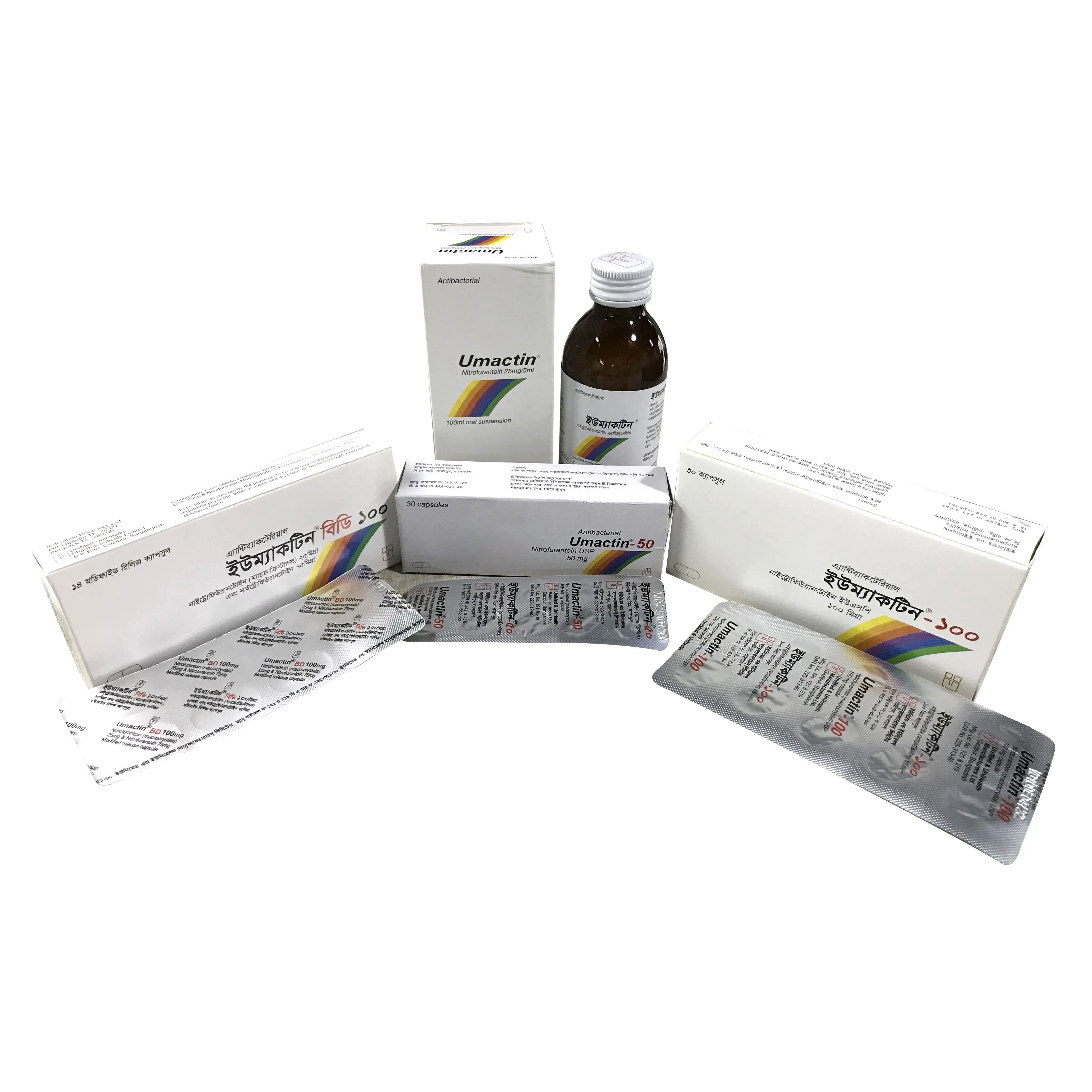Umactin BD Uses, Dosage, Side Effects and more
Each capsule contains two forms of nitrofurantoin. Twenty-five percent is macrocrystalline nitrofurantoin, which has slower dissolution and absorption than nitrofurantoin monohydrate. The remaining 75% is nitrofurantoin monohydrate contained in a powder blend which, upon exposure to gastric and intestinal fluids, forms a gel matrix that releases nitrofurantoin over time. This capsule is highly soluble in urine, to which it may impart a brown color. When administered with food, the bioavailability of nitrofurantoin is increased by approximately 40%.

| Attribute | Details |
|---|---|
| Trade Name | Umactin BD |
| Generic | Nitrofurantoin + Nitrofurantoin Microcrystals |
| Weight | 37.5mg+12.5mg, 75mg+25mg |
| Type | Capsule |
| Therapeutic Class | Systemic Urinary Anti- infective |
| Manufacturer | Unimed Unihealth MFG, Ltd |
| Available Country | Bangladesh |
| Last Updated: | January 7, 2025 at 1:49 am |
Uses
For the treatment of and prophylaxis against acute or recurrent, uncomplicated lower urinary tract infections or pyelitis either spontaneous or following surgical procedures. Nitrofurantoin is specifically used for the treatment of infections when due to susceptible strains of Escherichia coli, enterococci, staphylococci, Citrobacter, Klebsiella and Enterobacter.
Umactin BD is also used to associated treatment for these conditions: Acute Cystitis, Urinary Tract Infection
How Umactin BD works
Nitrofurantoin is converted by bacterial nitroreductases to electrophilic intermediates which inhibit the citric acid cycle as well as synthesis of DNA, RNA, and protein.
Dosage
Adults and Pediatric Patients Over 12 Years: One 100 mg capsule every 12 hours for seven days. Capsules should be taken with food.
The administration of high doses of nitrofurantoin to rats causes temporary spermatogenic arrest; this is reversible on discontinuing the drug. Doses of 10 mg/kg/day or greater in healthy human males may, in certain unpredictable instances, produce a slight to moderate spermatogenic arrest with a decrease in sperm count.
Nitrofurantoin should be taken with food.
How Long Does It Take to Work?
How Long Does It Take to Work? see here Umactin BD
Side Effects
In clinical trials of Macrobid, the most frequent clinical adverse events that were reported as possibly or probably drug related were nausea (8%), headache (6%), and flatulence (1.5%)
Toxicity
Symptoms of overdose include vomiting. In case of overdose, induce vomiting if it has not already occurred and increase fluid intake to promote urination. In extreme cases, nitrofurantoin can be removed from circulation by dialysis.
Precaution
If acute, sub-acute, or chronic pulmonary reactions occur, Nitrofurantoin should be discontinued. Antacid preparations containing magnesium trisilicate should not be taken while taking Nitrofurantoin
Interaction
Antacids containing magnesium trisilicate, when administered concomitantly with nitrofurantoin, reduce both the rate and extent of absorption. The mechanism for this interaction probably is adsorption of nitrofurantoin onto the surface of magnesium trisilicate. Uricosuric drugs, such as probenecid and sulfinpyrazone, can inhibit renal tubular secretion of nitrofurantoin. The resulting increase in nitrofurantoin serum levels may increase toxicity, and the decreased urinary levels could lessen its efficacy as a urinary tract antibacterial
Volume of Distribution
Data regarding the volume of distribution in humans is scarce but it has been reported as 0.46L/kg in dogs.
Elimination Route
Nitrofurantoin reaches a Cmax of 0.875-0.963mg/L with an AUC of 2.21-2.42mg*h/L. It is 38.8-44.3% bioavailable. Taking nitrofurantoin with food increases the absorption and duration of therapeutic concentrations in the urine.
Half Life
The half life of nitrofurantoin is 0.72-0.78h.
Clearance
The clearance of nitrofurantoin is 16.7-19.4L/h.
Elimination Route
27-50% of an oral dose is excreted in the urine as unchanged nitrofurantoin. 90% of the total dose is eliminated in the urine.
Pregnancy & Breastfeeding use
Pregnancy Category B. Nitrofurantoin has been detected in human breast milk in trace amounts. Because of the potential for serious adverse reactions from nitrofurantoin in nursing infants under one month of age, a decision should be made whether to discontinue nursing or to discontinue the drug, taking into account the importance of the drug to the mother.
Contraindication
Anuria, oliguria, or significant impairment of renal function are contraindications. This drug is contraindicated in pregnant patients at 38-42 weeks, during labor and delivery. Nitrofurantoin is also contraindicated in those patients with known hypersensitivity to Nitrofurantoin
Acute Overdose
Occasional incidents of acute overdosage of nitrofurantoin have not resulted in any specific symptoms other than vomiting. Induction of emesis is recommended. There is no specific antidote, but a high fluid intake should be maintained to promote urinary excretion of the drug. Nitrofurantoin is dialyzable.
Storage Condition
Store at 15-30° C



